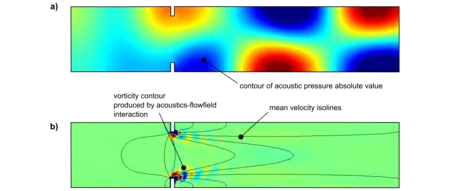Investigation and Modelling of High-Frequency Instabilities in Gas Turbine Combustion Chambers
Supervisor | Subject |
|---|---|
| Prof. Dr.-Ing. Thomas Sattelmayer | thermoacoustic instabilities, gas turbine combustors, high-frequency instabilities, transverse modes, transfer function |
Editor | Cooperation/Funding |
| Frederik Berger Dr.-Ing. Pedro Romero Vega M.Sc. | ALSTOM Power AG BMWi |
Motivation and Background
The development of novel combustion technologies for stationary gas turbines is motivated by high fuel flexibility and broad operability, while maintaining low pollutant emissions. Therefore, one of the preeminent challenges is the prevention of thermoacoustic oscillations in the combustion chamber. Those combustion instabilities are the result of constructive interference between the acoustic field and heat released by the combustion process. Resulting pressure waves limit operability ranges and reduce life span of gas turbines.
In the past decade, considerable advances have been made towards the prediction and prevention of low frequency pulsations. However, instabilities induced by high frequency (HF) and transverse oscillations have still not been adequately described and consequently cause a lack of understanding to arise concerning the occurrence, prediction and prevention of these oscillations.
Objectives
This project contributes to the development of a framework for comprehension and prediction of HF thermoacoustic instabilities. Experimental and numerical work will be carried out to identify the underlying causes and physical mechanisms of HF combustion dynamics as observed in industrial gas turbine combustors.
Experimental Approach
Experimental research on transverse thermoacoustic instabilities occurring at frequencies well above 1 kHz will be performed in order to target two combustor concepts. The first is a lean premix combustor with aerodynamic flame stabilization and the second is a reheat combustor that predominantly stabilizes itself by auto-ignition (cf. Fig. 1).
Schwing [1] experimentally exploited flame-acoustics feedback mechanisms for the aerodynamically stabilized flame and derived a theoretical model for the coupling of source term fluctuations and acoustic pressure/velocity. However, some physical mechanisms remain unknown and are subject of further research within this project.
The auto-ignition stabilized flame formally underlies different thermoacoustic feedback mechanisms. These instabilities are subject of a study in a newly developed second stage auto-ignition test rig. Measurement techniques for the determination of feedback mechanisms will comprise dynamic pressure and temperature monitoring simultaneous to (laser-) optical methods at high repetition rates. Regions of interest regarding feedback mechanisms are equivalence ratio fluctuations from the fuel feed system, impact of acoustics on coherent structures in the flame stabilization zone, as well as on the reaction kinetics within the auto-ignition process in combination with the effect of flame displacement. When conducting measurements of flame transfer characteristics, data sets will be delivered for implementation of numerical and analytical prediction tools.
Numerical Approach
An advanced numerical prediction methodology for aero-acoustic, entropy and vorticity wave propagation (cf. Fig. 2) has been developed at the Institute for Thermodynamics [2] that solves the Linearized Navier-Stokes Equations (LNSEs) in frequency domain. This method permits the registration of the influence of mean-flow on acoustics, e.g. damping due to vorticity production. In the process of this work, any thermoacustic feedback mechanisms observed will be implemented to extract growth-rates of complex thermoacoustic systems to provide numerical methods that serve as a basis for thermoacoustic prediction tools.
References
[1] J. Schwing. Über die Interaktion von transversalen akustischen Moden, Stömung und drallstabilisierter Flamme in zylindrischen Flammenrohren. PhD thesis, Technische Universität München, 2013.
[2] J. Gikadi. Prediction of Acoustic Modes in Combustors using Linearized Navier-Stokes Equations in Frequency Space. PhD thesis, Technische Universität München, 2014.
Acknowledgment
This project is funded by Alstom Power Generation AG and Bundesministerium für Wirtschaft und Energie, whose support is gratefully acknowledged.

